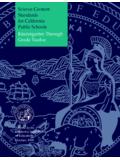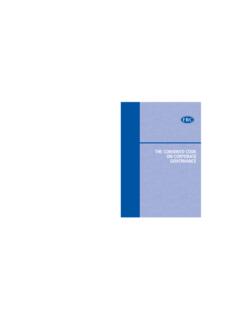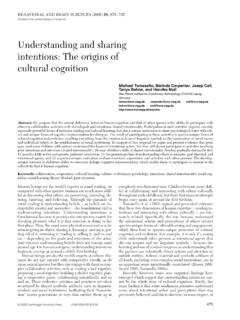Transcription of Gallery Text at the V and A Ten Point Guide
1 Gallery text at the V&AA Ten Point GuideDes 51995 Gallery Text at the V&A 13 .indd 103/09/2013 13:35 This complex and fascinating story is told with quite exemplary clarity. The label writing is a study in what can be done simply by the use of clear, elegant language to make difficult things accessible without a hint of Scotsman on V&A exhibition Encounters, 2004 This review from The Scotsman sums up what we are trying to achieve in the V&A. To write Gallery text that is interesting, engaging and accessible for a wide audience is difficult but not impossible. In doing so, we do not have to dumb down our scholarship and collections. Instead, we have to recognise people s needs and interests, and use the devices of good writing to communicate our ideas.
2 By good writing, we do not simply mean clarity and correct grammar. To appeal to readers and visitors, text also needs personality, life and guidelines are a quick survey of the main principles of writing good Gallery text. They have been written for V&A staff but may, of course, have a wider application. To refine and hone your style, you should study good and bad text wherever you are, whether visiting an exhibition or travelling on the have tried to include photographs of the objects that go with the labels. For copyright reasons, this has not always been possible but you will often be able to find the image on the the end of these guidelines, you will find a note on the planning and submission of Gallery Trench Educator and Interpretation Editor 20131 Des 51995 Gallery Text at the V&A 13.
3 Indd 203/09/2013 13:35 OneWrite for your audienceTwoStick to the text hierarchy and word countThreeOrganise your informationFour Engage with the object Five Admit uncertaintySixBring in the human elementSeven Sketch in the backgroundEightWrite as you would speakNineConstruct your text with careTenRemember Orwell s Six Rules2 Des 51995 Gallery Text at the V&A 13 .indd 303/09/2013 13:35 ONEWRITE FOR YOUR AUDIENCES urveys show that in 2012 13 visitors to V&A South Kensington had the following profile: 41% had completed a university degree or equivalent qualification 25% had completed a postgraduate degree or equivalent qualificationFrom this one might assume that our visitors tend to be well educated.
4 This is true, but the one most important thing to remember is that they are unlikely to be educated in the subject you are writing about. If they do have a specialist area, it might be in Renaissance book production not Buddhist sculpture. 14% of our visitors were still in education in 2012 13, so they are likely to be young, with different areas of knowledge from older people. We need to be aware of this, and also of visitors who have limited reading skills or are not fluent in is not to say you should write specifically for these particular audiences. If you do, you might sound patronising and alienate our core audience. Instead, you should work on tone, balance and the skilful manipulation of words and ideas to make your text widely , different displays attract different audiences and so need a different approach.
5 It is absolutely right, and one of the strengths of the V&A, that the text for the David Bowie is exhibition (2013) didn t sound like that for the Sculpture in Britain Gallery . The principles are the same; the tone is 51995 Gallery Text at the V&A 13 .indd 403/09/2013 13:35In the 1990s the Getty Museum identified what it called the art novice . It defined this hypothetical visitor as follows: Is curious and motivated to learn Spends less than 30 seconds looking at an object Has underdeveloped perceptual skills Is unfamiliar with art terminology Expects a quick pay off ( art should grab me ) Senses that their knowledge is limited and limiting to their enjoyment Lacks confidence in their ability to make sense of what they see Makes emotional and personal associations with the object first Wants to connect with the people associated with the objectWith this in mind, look at the text overleaf on the mirror frame.
6 Imagine you are passing through the Gallery on your way to the caf . You know nothing about Renaissance art and are reading this label with an aged aunt who has lost her glasses and a small child who wants to know what it is about now. You have 30 51995 Gallery Text at the V&A 13 .indd 503/09/2013 13:355 Why is it called a mirror frame when it doesn t have a mirror and doesn t look like a frame? What is an emblematic female head? What is it doing here? Can you be bothered to go and find the other mirror frame in Room 14? Who is Vecchietta? Have you ever heard of him? Who is the writer talking to? Any visitor walking through the Gallery , or specially to a fellow curator?This text was probably written in the 1970s but it remained in Room 17 until 2006.
7 Presumably it was once perfectly acceptable, but times have changed and now more people go to museums than to football matches. Most visitors are no more likely to know about the material culture of the Renaissance than a museum curator is likely to understand the offside FRAME Painted Cartapesta (papier m ch ) Workshop of NEROCCIO DEI LANDI (1447 1550) SIENNESE; last quarter of the 15th century 850 1884 This type of mirror frame, showing an emblematic female head, exists in several examples in various media; a maiolica version ( ) is exhibited in room 14. This work is characteristic of NEROCCIO DEI LANDI, who trained under Vecchietta and was active in Siena both as a painter and a 51995 Gallery Text at the V&A 13.
8 Indd 603/09/2013 13:356We have now rewritten the label to explain why the mirror frame looks as it does and to explain the concept behind the in the V&A there are still labels that are addressed to fellow curators. They refer to places, people and objects that most visitors couldn t possibly recognise. They fail to explain what the exhibit is, or why it looks as it does, on the assumption that the visitor already knows. And they often follow the academic convention of analysing a situation and then offering a conclusion. But with less than 30 seconds to look at an object, visitors need the conclusion immediately. Instead, we should be looking at the approach used in journalism, in which the hook or the most important Point comes first, as in this label for the Gaigni res-Fonthill FRAME About 1475 1500 Workshop of Neroccio dei Landi (1447 1550)The mirror, which is now missing, would have been a disc of blown glass or polished metal.
9 As well as being an expensive novelty, mirrors were thought to reveal the inner truth. This frame invited a moral comparison, since the viewer s face appeared below the beautiful (and therefore virtuous) image above. [52 words]Italy, Siena Painted cartapesta (papier m ch )Museum no. 850-1884 Des 51995 Gallery Text at the V&A 13 .indd 703/09/2013 13:357 This label illustrates many of the virtues of good Gallery text: It gets straight to the Point It has been crafted for a specific context. The theme here is the story of the early Asian imports into Europe It has, in miniature, a pyramidal structure in which the information becomes increasingly detailed and argued There is a human presence in the phrase his kingdom There is a sense of action in the phrases passing through and had the vase mounted It assumes no knowledge of history, nor does it patronise the reader.
10 To say the famous collector William Beckford would be patronising. This wording is not. The sentences vary in length, which makes for a lively text The first sentence is short. (We recommend that where possible the first sentence should be under 16 words)THE GAIGNI RES-FONTHILL VASE China Yuan dynasty; about 1300 30 This is the earliest recorded piece of Chinese porcelain in Europe. It was owned by Louis the Great of Hungary, who was probably given it in 1338, when a Chinese embassy passed through his kingdom on its way to the Pope. In 1381 the king had the vase mounted as a gift for Charles III of Naples. It was later owned by a number of important collectors, including the Duc de Berry and William Beckford.





